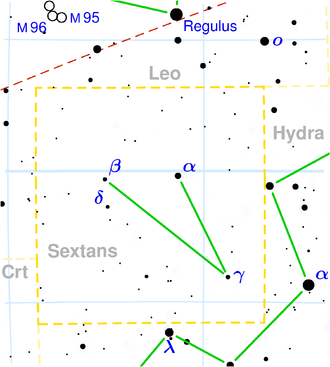NGC 3017
| Galaxie NGC 3017 | |
|---|---|
 | |
| SDSS-Aufnahme | |
| AladinLite | |
| Sternbild | Sextant |
| Position Äquinoktium: J2000.0, Epoche: J2000.0 | |
| Rektaszension | 09h 49m 03,0s[1] |
| Deklination | -02° 49′ 19″ [1] |
| Erscheinungsbild | |
| Morphologischer Typ | E [1] |
| Helligkeit (visuell) | 13,5 mag [2] |
| Helligkeit (B-Band) | 14,5 mag [2] |
| Winkelausdehnung | 1′ × 1′ [2] |
| Flächenhelligkeit | 13,6 mag/arcmin² [2] |
| Physikalische Daten | |
| Rotverschiebung | 0.020778 ± 0.000117 [1] |
| Radialgeschwindigkeit | (6229 ± 35) km/s [1] |
| Hubbledistanz vrad / H0 | (271 ± 19) · 106 Lj (83,1 ± 5,8) Mpc [1] |
| Geschichte | |
| Entdeckung | Ormond Stone |
| Entdeckungsdatum | 1886 |
| Katalogbezeichnungen | |
| NGC 3017 • PGC 28220 • CGCG 007-040 • MCG +00-25-019 • 2MASX J09490301-0249180 • | |
NGC 3017 ist eine elliptische Galaxie vom Hubble-Typ E[2] im Sternbild Sextant am Südsternhimmel. Sie ist schätzungsweise 271 Millionen Lichtjahre von der Milchstraße entfernt.
Das Objekt wurde im Jahre 1886 von Ormond Stone entdeckt.[3]
Weblinks
Einzelnachweise
Auf dieser Seite verwendete Medien
Autor/Urheber: Sloan Digital Sky Survey, Lizenz: CC BY 4.0
The sky image is obtained by Sloan Digital Sky Survey, DR14 with SciServer.
Angle of view: 4' × 4' (0.3" per pixel), north is up.
Details on the image processing pipeline: https://www.sdss.org/dr14/imaging/jpg-images-on-skyserver/



